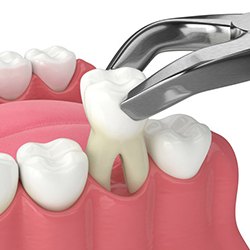Pulp Therapy – Wylie, TX
Root Canals to Save Growing Smiles

Imagine that your child is in a lot of pain from an ailing tooth—they clearly have a dental emergency. Although this situation can be stressful to say the least, our team here at Wylie Children’s Dentistry can give them lasting relief through either root canal therapy or pulp therapy. Pulp therapy is essentially very similar to a root canal procedure, except it is performed on primary or baby teeth, which are much smaller and thinner than adult teeth. To learn more about these treatments and how we can help preserve your child’s natural smile, give our office a call!
Why Choose Wylie Children’s Dentistry for Pulp Therapy?
- Same-Day and Weekend Emergency Appointments Available
- Most Dental Insurance Accepted
- Sedation Offered for Nervous Patients
Does My Child Need Pulp Therapy/Root Canal Therapy?

Although tooth pain is a common symptom before pulp therapy or a root canal, it is not a requirement. When a tooth has become deeply infected or damaged and reached the vulnerable center of the tooth, which is called the pulp, that’s when one of these procedures is necessary. After looking at X-rays of your child’s teeth, Dr. Pearson will recommend the appropriate treatment according to their needs and situation.
The Root Canal Process

Before we begin the treatment, we will administer a local anesthetic to the affected area. This numbs any pain your child may be experiencing and means that they will not feel anything during the procedure. If necessary, we also have sedation options that can help your child feel at ease and more calm. Then Dr. Pearson will delve into the tooth to remove all infected tissue and the pulp. Once the inner chamber is cleaned and sealed, the exterior tooth structure can be restored with a filling or a dental crown, which can be made of various materials.
The Benefits of Getting a Root Canal

In many cases, the alternative to root canal or pulp therapy is extracting the tooth entirely. Removing a baby tooth prematurely may not initially seem significant—they fall out eventually anyway—but they actually help the permanent teeth align more correctly as they are still developing below the gum surface. In addition, the permanent teeth are supposed to last a lifetime or at least well into adulthood, and losing one early in life can lead to issues with self-confidence as well as functional problems like difficulty eating. Pulp therapy and root canals save millions of teeth every year from being extracted.
Plus, Dr. Pearson is very gentle with patients. These procedures are not painful because we make sure your child is perfectly comfortable the whole time they are under our care.
Understanding the Cost of Pulp Therapy/Root Canal Treatment

When it comes to pulp therapy or root canal treatment for your child, you typically won’t expect to find a set fee for the procedure due to every patient being different. Our team will evaluate your little one’s oral health and provide you with an estimate of the price during the initial consultation. We’ll also go over your financing options that can help minimize your out-of-pocket expenses while helping your child regain a healthy and comfortable bite. Until then, here’s what to know about the cost of pulp therapy.
Factors That Can Affect the Cost of Pulp Therapy

Our team will need to keep several considerations in mind when it comes to the price of your child’s procedure, such as the type of tooth involved (primary or adult), where in the mouth it’s located, the number of teeth needing treatment, and how infected their tooth is. During their initial consultation, we’ll thoroughly assess their situation and then walk you through the estimated cost you might expect from the service. Of course, if they have any other underlying issues that need to be addressed, this can add to the overall price of pulp therapy.
Is it Cheaper to Remove My Child’s Tooth?

In certain circumstances, like if your little one already has a baby tooth that is close or ready to come out, extracting it may be the more affordable move compared to performing pulp therapy. However, in the cases where it’s a permanent tooth or the primary tooth has a long time before it’s meant to come out on its own, you might be better off saving their pearly whites instead. Removing the tooth ahead of its time may involve additional treatment, such as space maintainers or tooth replacements, which can increase the total cost.
Does Dental Insurance Cover Pulp Therapy?

Since pulp therapy is designed to save an otherwise healthy natural tooth, most dental insurance companies can offer coverage for the procedure. That said, the exact amount included in your benefits will depend on the details of your policy, as every plan is different. In the majority of cases, insurance providers might help pay half of the cost, meaning you’ll need to pay the other half out of pocket. Feel free to speak with our front desk team so they can help navigate your policy and develop a plan to make the most of your perks.
Other Options for Making Pulp Therapy Affordable

If you currently don’t have insurance, this doesn’t mean you’ll be out of options for minimizing your expenses. Our team is happy to offer help through our KLEER® Dental Membership Plan, which allows you to enjoy significant discounts on various services with just one low monthly or annual cost. We’re also partnered with CareCredit—a third-party financier that can turn the overall cost of your treatments into monthly, low-to-no-interest payments!
Pulp Therapy FAQs

Would you like to learn more about pulp therapy in Wylie? From if it’s painful and why it’s necessary to how this treatment can be prevented, we’ve dedicated an entire section to answering frequently asked questions we get from parents. As always, if you have a specific question on your mind (or you can’t find the answer you’re looking for below), you can always get in touch with our team directly!
My Child Says Their Tooth Doesn’t Hurt – Do They Still Need Pulp Therapy?
In short, while pain is a symptom of a damaged tooth, it isn’t the only one. In fact, if the decay has been left alone to progress for long enough, it can “kill” the nerve of the tooth, causing the discomfort to stop. That’s why it’s so important that you bring your child in for a checkup and cleaning every six months. This allows our team to detect the problem and treat it before it becomes necessary to conduct a root canal or, in more severe cases, extract the tooth entirely.
Is Pulp Therapy Painful?
For children and adults alike, one of the first questions they ask when discussing root canal therapy is, “Will it hurt?” Fortunately, the answer is “no.” Although treatment plans vary, the first step is always the same: administering a local anesthetic. This will numb your child’s mouth so they don’t experience any discomfort in the treatment chair. If they are still nervous or have trouble relaxing, then we may recommend sedation dentistry as well. This will help them get the essential dental care they need in the positive, comfortable atmosphere they deserve.
Can Root Canals Be Prevented?
Mostly, yes! Priority number one is helping your child implement a solid oral hygiene routine from a young age, including brushing their teeth each morning and evening. As they get older, they should begin flossing and rinsing with mouthwash as well to help remove plaque and prevent tartar build-up. Of course, their biannual visits to our office are also important. These periodic visits serve two important purposes: catching decay and infection in the early stages and preventing oral health problems from developing in the future!
There are several additional steps you can take that may not be as obvious, including having your child wear a mouthguard during sporting events, limiting their intake of added sugar, and helping them avoid unhealthy dental habits, like chewing on ice or pen caps. Of course, if you would like personalized recommendations, then don’t hesitate to ask us at your child’s next visit!
What Happens If My Child Waits Too Long for a Root Canal?
Since teeth cannot heal on their own, waiting too long for a root canal can wreak havoc on your child’s oral health. As mentioned above, the decay or infection can spread with each passing day, resulting in pain when biting down, discomfort that makes it difficult to concentrate, and other negative effects. If it’s caught and treated in the initial stages, the solution may be a simple filling. If it’s left alone to progress for months or years, then saving the tooth may no longer be feasible, requiring an extraction.
